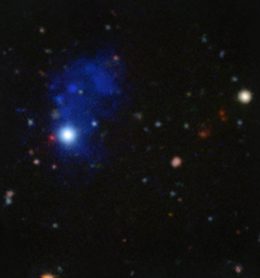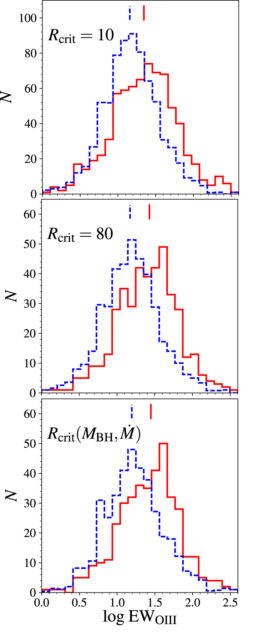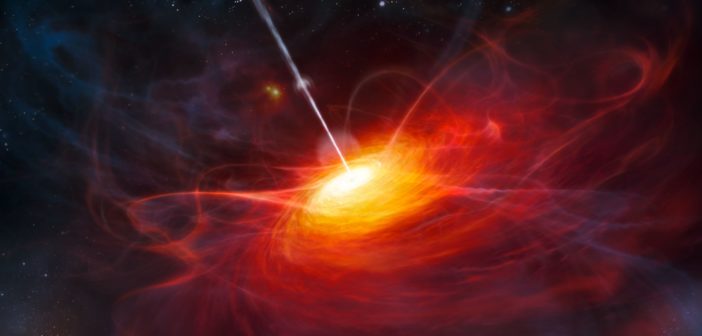
A cloud of gas surrounds the distant quasar SDSS J102009.99+104002.7 in this image from ESO’s Very Large Telescope. The name “quasar” is a shortening of “quasi-stellar radio source”, though we now know that only a small fraction of quasars are radio-loud. [ESO/Arrigoni Battaia et al.]
Loud and Quiet Quasars
Quasars, the most luminous type of active galactic nuclei, are powered by the accretion of material onto the supermassive black holes located at the centers of the galaxies. These distant beasts tend to fall into two general categories:
- radio-loud quasars, which host powerful relativistic radio jets and make up roughly 10% of the quasar population, and
- radio-quiet quasars, which feature only weak core radio emission and make up the remaining 90% of quasars.
What causes this distinction in jet behavior? Many theories have been put forward, but today we’ll explore one potential factor in particular: the spin of the black hole.

Histogram of the [O III] equivalent width for radio-loud (solid red) vs. radio-quiet (dashed blue) quasars, for three different definitions of radio-loudness. [Adapted from Schulze et al. 2017]
A Tricky Measurement
Past studies examining the spin paradigm suggest that it doesn’t hold up — several radio-quiet quasars were found to host black holes with apparently high spin. But measuring black-hole spins is notoriously tricky, with each method relying on a number of inferences. It’s possible that the method used to infer the high spins of these radio-quiet quasars might not have yielded accurate results.
A team of scientists led by Andreas Schulze (National Astronomical Observatory of Japan) has now proposed an alternative approach to test the spin paradigm. Schulze and collaborators suggest using the strength of a particular emission line, [O III], to indirectly measure the black holes’ average radiative efficiency — i.e., how much of the energy of the mass accreting onto the black holes is converted into radiation. If the average efficiency for a sample of radio-loud quasars is different than that for a sample of radio-quiet quasars, this would mean a difference in black-hole spins for the two samples.
Counting Spin Back In
Using a sample of nearly 8,000 quasars identified in the Sloan Digital Sky Survey, the authors find that the [O III] line strength is enhanced by a factor of at least 1.5 in a radio-loud sample, compared to a radio-quiet sample matched in redshift, black-hole mass, and accretion rate.
![EW[O III] vs. redshift](https://aasnova.org/wp-content/uploads/2017/11/fig4-4-260x211.jpg)
[O III] equivalent width for the radio-loud (solid red) and radio-quiet (dashed blue) samples as a function of redshift. [Schulze et al. 2017]
The authors caution that, like other tactics used to learn about black-hole spins, their approach relies on a number of key assumptions — and their results certainly don’t mean that spin must be the only factor differentiating between radio-loud and radio-quiet quasars. The results do suggest, however, that we shouldn’t count spin out of the game: it may play an important role in determining the loudness of these distant accreting monsters.
Citation
Andreas Schulze et al 2017 ApJ 849 4. doi:10.3847/1538-4357/aa9181


2 Comments
Pingback: Astronomia: alcuni quasar sono più "rumorosi" di altri, ecco perché - Meteo Web
Pingback: Quasar a tutto volume – La Macchina del Tempo